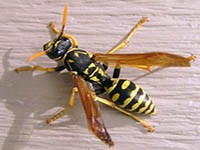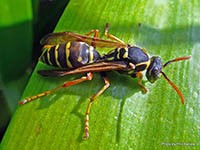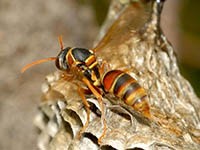Paper wasps were one of the five species of wasps that were introduced to New Zealand by mistake in the 1940’s. There are a few different types of paper wasps; Asian, European, and Australian. Each of these wasps can only be found in certain parts of the country, with the Asian paper wasp in the North Island and top of the south. The Australian paper wasp remains confined to the north of the North Island. And the European paper wasp mostly found the in the upper South Island.

European Paper Wasp |

Asian Paper Wasp |

Australian Paper Wasp |
Paper wasps get their name from the paper-like material that they use to build their nests. Their nests are small, around the size of a pear and made from regurgitated woody material. Paper wasps are slender with long legs that dangle beneath their bodies when they fly. The European paper wasps are black and yellow in colour and resemble yellow jackets.
Although paper wasps are social and live in colonies, their nests do not grow as big in number as the Common and German wasps. Once the paper wasps nest reaches around 30-40 wasps, they will start producing new queens and drones. The queens will mate with the drones then start a new colony not too far from the nest it came from. With it only taking 2 weeks for a paper wasp to become an adult it does not take long to grow a nest. Meaning that if you find one nest, you are bound to find some more not too far away.
Why are Paper Wasps a pest?
Paper wasps are classed as a pest, mostly because of what they eat. Paper wasps feed on insects including caterpillars, spiders, flies, crickets, and some of our native insects. They are also attracted to the sugar in the juices of ripening fruits and the nectar of flowers.
These wasps have become competitors for food with our other native wildlife, and a threat to our native insects as most of the paper wasps’ natural predators are not in New Zealand. They are also a pest for our fruit and orchard growers, although they do keep other insects away from the fruit such as aphids and caterpillars, they are do damage to the crops when its ripening and ready to pick.
What can you do to stop Paper Wasps?
Prevention is always a good idea and reducing nesting sites for paper wasps before the colonies are established in spring is the best idea. Paper wasps look for places that are sheltered like shrubs, in window or door frames, in fences and attics. Also, in and around things that might be laying around the yard that haven’t been moved in a while. Cleaning up your outdoor areas and moving things away from vegetable gardens and orchards will make it less appealing for paper wasps to establish nests nearby. However, you cannot always stop them from nesting if you find an exposed nest you could used our Hawkeye FAR Spray. You do need to make sure that you are treating a paper wasp nest and not a Common or German wasps’ nest, as these are more aggressive towards people with significantly larger nests. Because paper wasps are not as aggressive as other wasps, they will not show any aggression or try to attack you when sprayed with our FAR spray. The ideal times to spray a paper wasps’ nest is the early morning or late evening when the adults have returned to the nest and less active. You should always read the directions on the label and apply as directed.